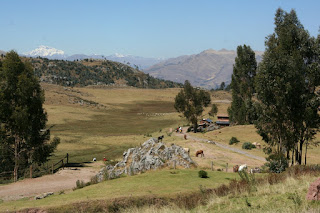 |
| Hot tamales |
We met our horse wrangler, Raúl, near to the Temple of the Moon and saddled ourselves with a couple of small horses. These we rode up the steep hill to the twin sites of Tambomachay and Pukapukara. I say "rode", as the horses did all the work and stubbornly refused to obey any commands or pulls of the rein, stopping for regular snacking on the abundant flora. As this was my third time in the saddle during this trip, if there was any danger of feeling competent, my mount dispelled any such thought.
 |
| Horses in the valley |
Both sites are much smaller than the sprawling Sacsaywamán, with Pukapukara apparently being an extension of the Inca fortification, strategically positioned on top of a hill giving an excellent vantage point over the surroundings.
 |
| Pukapukara |
Tambomachay, in contrast, is one of the constructions in which water (one of the elements revered by the Incas) features heavily. Small cascades of water flow still through the typically precisely engineered masonry. It is said that this was "the baths" of the Incas, although whether this was recreational or ceremonial, nobody seems to know.
 |
| Tambomachay |
Taking the horses - relieved, I'm sure - back down the hill, we stopped at the mysterious "Zona X" - a series of natural passageways through the rocks augmented by precisely carved Inca recesses of unknown purpose. The monicker suggests that, again, nobody is sure what the caves are for.
A quick trot led us to our final stop - the equally mysterious Q'enqo ruins. Its name apparently means 'labyrinth', owing to the zig-zag channels cut through its rocky bulk. Historians conjecture that these flowed with liquid (water, blood, chicha?) and with the altar carved into the internal chamber, it most likely had a funereal purpose. Of course, with little written tradition, save for a few paintings, few can be certain of its true function.
We left our horses and joined our host, Mary, in town. Meeting her for lunch, we recommended and introduced to her the Shaman vegan restaurant. After a few mouthfuls, she was converted. "I could eat here every day," she exclaimed. We were pleased.
Our lunch of falafel and enrollada de verduras was accompanied by a troupe of Andean musicians.
A quick trot led us to our final stop - the equally mysterious Q'enqo ruins. Its name apparently means 'labyrinth', owing to the zig-zag channels cut through its rocky bulk. Historians conjecture that these flowed with liquid (water, blood, chicha?) and with the altar carved into the internal chamber, it most likely had a funereal purpose. Of course, with little written tradition, save for a few paintings, few can be certain of its true function.
We left our horses and joined our host, Mary, in town. Meeting her for lunch, we recommended and introduced to her the Shaman vegan restaurant. After a few mouthfuls, she was converted. "I could eat here every day," she exclaimed. We were pleased.
 |
| Shamanic lunxh |
Our lunch of falafel and enrollada de verduras was accompanied by a troupe of Andean musicians.
No comments:
Post a Comment